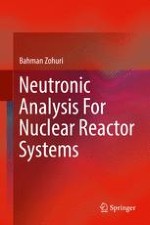2017 | OriginalPaper | Buchkapitel
3. Spatial Effects in Modeling Neutron Diffusion: One-Group Models
verfasst von : Bahman Zohuri
Erschienen in: Neutronic Analysis For Nuclear Reactor Systems
Aktivieren Sie unsere intelligente Suche, um passende Fachinhalte oder Patente zu finden.
Wählen Sie Textabschnitte aus um mit Künstlicher Intelligenz passenden Patente zu finden. powered by
Markieren Sie Textabschnitte, um KI-gestützt weitere passende Inhalte zu finden. powered by
